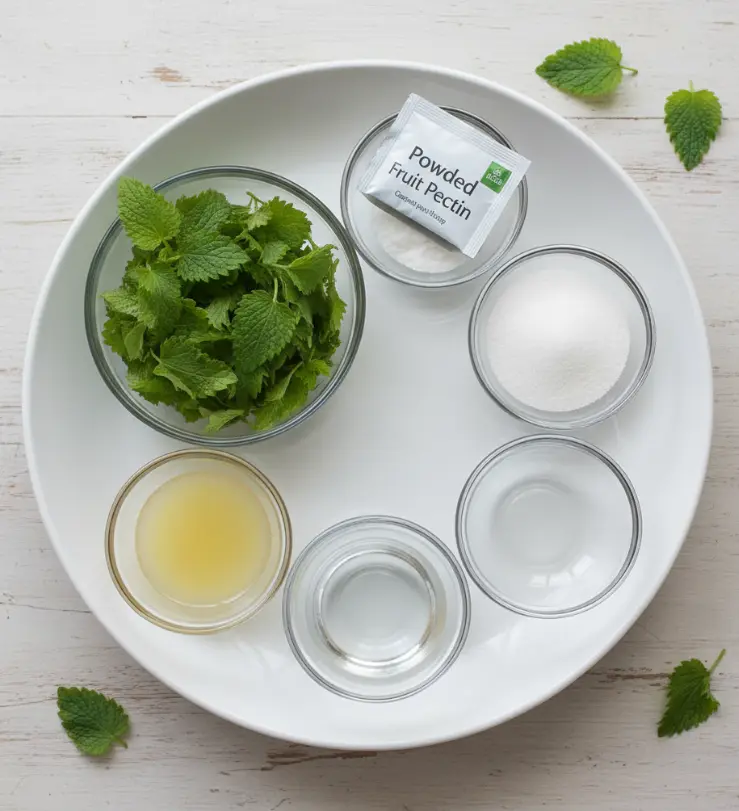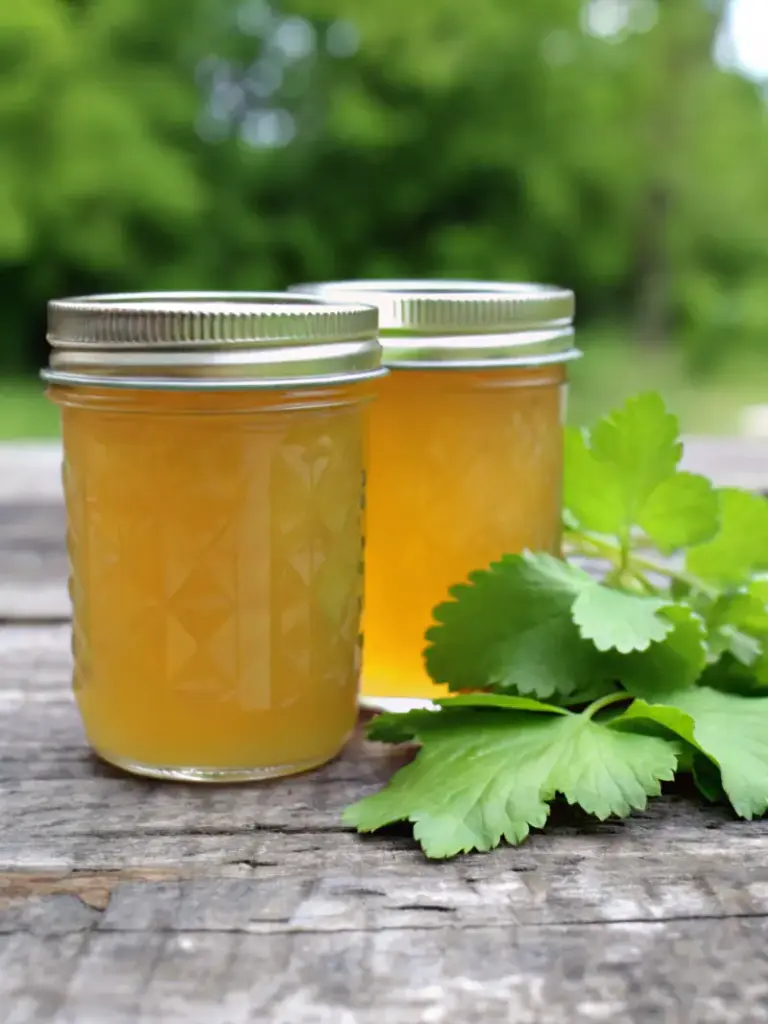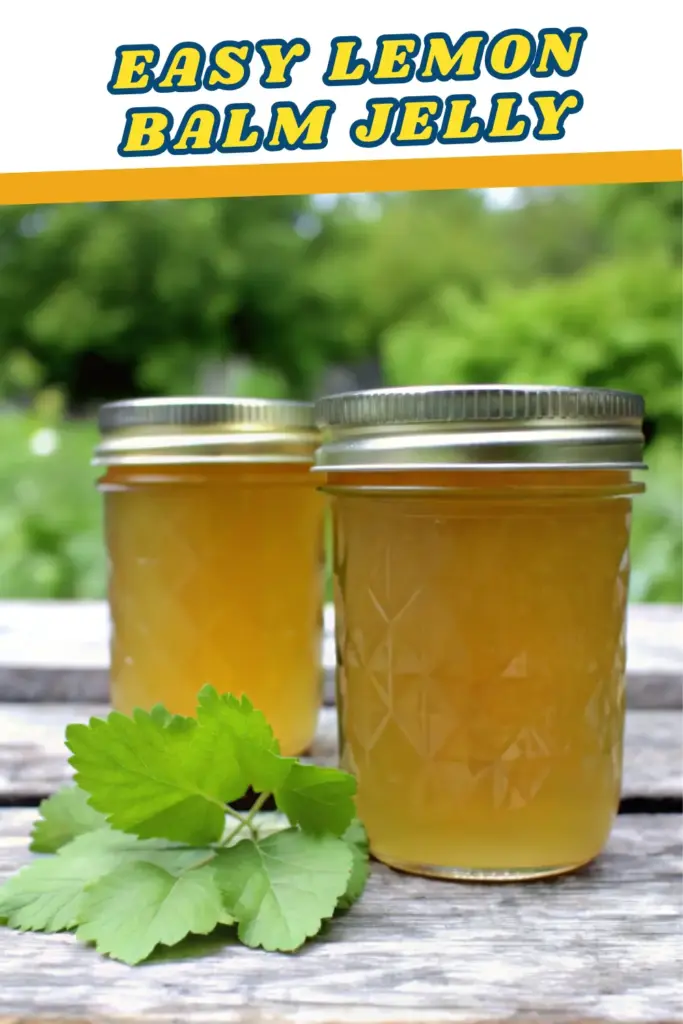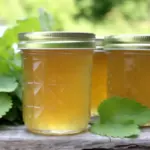Did you know that lemon balm (Melissa officinalis) has been cherished for over 2,000 years for its calming properties and citrusy aroma? While most people enjoy it as tea, have you ever considered transforming this fragrant herb into a delightful lemon balm jelly? This unique preserve captures the essence of summer in every spoonful, offering a versatile condiment that’s as at home on your morning toast as it is glazing roasted chicken. Our tested recipe yields approximately 5 half-pint jars of this golden, herb-infused jelly that’s surprisingly simple to make at home. Whether you’re an experienced canner or trying your hand at preserving for the first time, this lemon balm jelly recipe will become a staple in your pantry.
Ingredients List
Gather these simple ingredients to create your own batch of lemon balm jelly:
- 3 to 4 cups fresh lemon balm leaves (harvested from pesticide-free plants, about 1 quart loosely packed)
- 1 box (1.75 oz) powdered pectin (regular or low-sugar variety)
- 1 to 4 cups granulated sugar (adjust based on your sweetness preference)
- 2 tablespoons fresh lemon juice (bottled works too, but fresh adds brighter flavor)
- 4 cups filtered water
Pro Tip: For the best flavor, harvest lemon balm leaves in the morning after the dew has dried but before the sun gets too hot. This is when the essential oils are most concentrated.
Timing
- Prep Time: 20 minutes (including steeping)
- Cook Time: 10 minutes
- Canning Time: 10-15 minutes
- Total Time: 40-45 minutes (plus cooling time)
Compared to traditional fruit jellies that require hours of cooking, this lemon balm jelly comes together in less than an hour, making it a perfect weekend project.
Step-by-Step Instructions
Step 1: Prepare Your Equipment
Start by sterilizing your canning jars and lids. This ensures your lemon balm jelly stays fresh and safe for long-term storage. Keep the jars hot until you’re ready to fill them.
Step 2: Harvest and Clean
Gently harvest your lemon balm leaves, choosing the healthiest, brightest green leaves. Rinse them thoroughly under cool running water to remove any dirt or insects. Pat dry with a clean kitchen towel.
Step 3: Create the Infusion
Place the cleaned lemon balm leaves in a large heatproof bowl. Bring 4 cups of water to a rolling boil, then pour over the leaves. Cover and let steep for 10-20 minutes, depending on how strong you want the flavor.
Step 4: Strain and Prepare
Strain the liquid through a fine-mesh sieve or cheesecloth into a large saucepan. Press gently on the leaves to extract all the flavorful liquid. Discard the spent leaves.
Step 5: Add Lemon and Pectin
Stir in the lemon juice, then bring the mixture to a full rolling boil over high heat. Add the pectin all at once, stirring constantly to prevent clumping. Maintain a vigorous boil for exactly 1 minute.
Step 6: Add Sugar
After the minute is up, gradually add your desired amount of sugar (start with 2 cups for a less sweet version or up to 4 cups for traditional sweetness). Return to a full boil and cook for exactly 1 more minute, stirring constantly.
Step 7: Jar and Process
Remove from heat and skim off any foam. Ladle the hot jelly into prepared jars, leaving ¼ inch headspace. Wipe the rims clean, apply lids and rings, and process in a water bath canner for 10 minutes (15 minutes if above 6,000 feet elevation).

Nutritional Information
| Nutrient | Amount per 1 tbsp serving |
|---|---|
| Calories | 68 kcal |
| Carbohydrates | 18g |
| Sugars | 17g |
| Protein | 0.01g |
| Fat | 0.1g |
| Sodium | 3mg |
| Vitamin C | 0.2mg |
Note: Using low-sugar pectin and reducing sugar to 1 cup can lower the calorie count to approximately 20 calories per tablespoon.
Healthier Alternatives
Transform this already wholesome recipe into an even healthier version with these simple swaps:
- Sugar Alternatives: Replace up to half the sugar with raw honey or pure maple syrup (though this may affect the set)
- Low-Sugar Option: Use low-sugar pectin and reduce sugar to 1 cup for a diabetic-friendly version
- Vegan Version: Substitute regular pectin with Pomona’s Universal Pectin, which works with low-sugar and alternative sweeteners
- Herbal Boost: Add a tablespoon of grated fresh ginger or a few sprigs of lavender during steeping for added health benefits
Serving Suggestions
This versatile lemon balm jelly shines in both sweet and savory applications:
- Spread on warm scones or toast for a delightful breakfast
- Glaze for roasted chicken or pork tenderloin
- Swirl into plain yogurt or oatmeal
- Pair with sharp cheeses on a charcuterie board
- Use as a filling for thumbprint cookies
- Stir into vinaigrettes for a bright, herbal note
Chef’s Tip: For an elegant appetizer, spread cream cheese on crackers and top with a dollop of lemon balm jelly and a sprinkle of lemon zest.

Common Mistakes to Avoid
- Insufficient Steeping Time: Don’t rush the steeping process. The full 20 minutes ensures maximum flavor extraction.
- Inaccurate Sugar Measurements: Too little sugar can prevent proper setting, while too much can overwhelm the delicate lemon balm flavor.
- Incomplete Sterilization: Always start with properly sterilized jars to prevent spoilage.
- Overcooking: Boil for exactly the recommended time to maintain the jelly’s fresh flavor and proper set.
- Skipping the Lemon Juice: The acid is crucial for both flavor and safe canning.
Storing Tips
Proper storage ensures your lemon balm jelly stays fresh and delicious:
- Unopened Jars: Store in a cool, dark place for up to 1 year
- Opened Jars: Refrigerate and use within 3 months
- Freezing: For longer storage, freeze in airtight containers for up to 6 months
- Gift-Giving: Decorate with fabric toppers and ribbon for beautiful homemade gifts
Pro Tip: Always label your jars with the date made. The flavor actually improves over the first month as the ingredients meld together.
Conclusion
Creating your own lemon balm jelly is a rewarding way to preserve the fresh taste of summer. With its bright, citrusy flavor and beautiful golden color, this versatile preserve makes a wonderful addition to any pantry. Whether you’re enjoying it on your morning toast or using it to glaze your favorite protein, this jelly brings a touch of herbal elegance to every bite. Have you tried making lemon balm jelly before? Share your experience in the comments below, and don’t forget to subscribe for more delicious preserving recipes!

FAQs
Q: Can I use dried lemon balm instead of fresh?
A: Yes, you can substitute dried lemon balm. Use about 1/3 the amount of fresh (approximately 1 to 1.5 cups dried leaves). The flavor may be slightly more concentrated.
Q: Why didn’t my jelly set properly?
A: Several factors can affect setting: inaccurate sugar measurements, insufficient boiling time, or old pectin. You can try reboiling with additional pectin if needed.
Q: How long does it take for the jelly to set?
A: Allow 12-24 hours for the jelly to fully set. If it’s still runny after this time, it may need to be reprocessed.
Q: Can I make this without pectin?
A: While possible, it’s not recommended as lemon balm is naturally low in pectin. Without added pectin, the jelly may not set properly.
Q: Is lemon balm jelly safe for water bath canning?
A: Yes, this recipe is specifically designed for safe water bath canning when processed correctly for the recommended time.

How to Make Lemon Balm Jelly | Step-by-Step Guide
- Total Time: 45 minutes
- Yield: 5 half-pint jars 1x
Description
Capture the essence of summer with this bright, citrusy Lemon Balm Jelly. Lightly herbal, beautifully golden, and perfect for spreading on toast or glazing savory dishes — a refreshing homemade preserve that delights in every spoonful.
Ingredients
- 3 to 4 cups fresh lemon balm leaves (about 1 quart loosely packed)
- 1 box (1.75 oz) powdered pectin (regular or low-sugar)
- 1 to 4 cups granulated sugar (to taste)
- 2 tablespoons fresh lemon juice
- 4 cups filtered water
Instructions
- Sterilize jars and lids, keeping them hot until ready to fill.
- Rinse and dry fresh lemon balm leaves.
- Place leaves in a large heatproof bowl and pour 4 cups boiling water over them. Cover and steep for 10–20 minutes.
- Strain through cheesecloth into a saucepan, pressing out all liquid.
- Add lemon juice and bring to a full rolling boil.
- Stir in pectin, boiling for 1 minute while stirring constantly.
- Add sugar gradually (2–4 cups), return to a full boil, and cook 1 more minute.
- Remove from heat, skim foam, and ladle hot jelly into sterilized jars, leaving ¼-inch headspace.
- Wipe rims, apply lids, and process in a boiling water bath for 10 minutes (15 minutes above 6,000 ft).
Notes
Store unopened jars in a cool, dark place for up to 1 year. Refrigerate opened jars and use within 3 months. For lower sugar versions, use low-sugar pectin and reduce sugar to 1 cup. Perfect for toast, cheeses, or glazing meats.
- Prep Time: 20 minutes
- Cook Time: 10 minutes
- Category: Preserve
- Method: Canning
- Cuisine: American
Nutrition
- Serving Size: 1 tablespoon
- Calories: 68
- Sugar: 17g
- Sodium: 3mg
- Fat: 0.1g
- Saturated Fat: 0g
- Unsaturated Fat: 0g
- Trans Fat: 0g
- Carbohydrates: 18g
- Fiber: 0g
- Protein: 0.01g
- Cholesterol: 0mg





